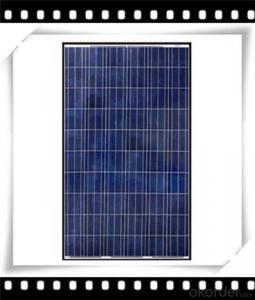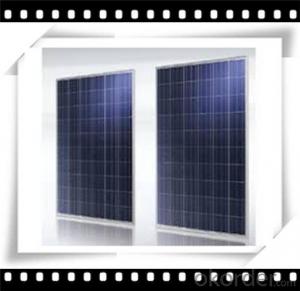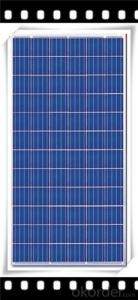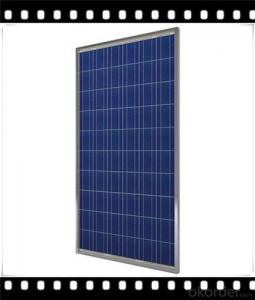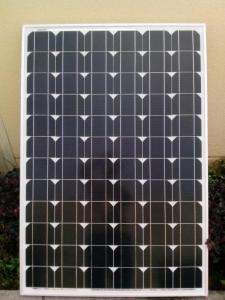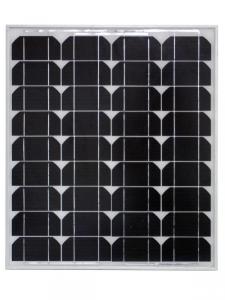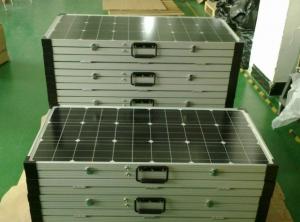Aaa Solar Panels 250w Poly Medium Newest CNBM Solar Panel
- Loading Port:
- Qingdao
- Payment Terms:
- TT OR LC
- Min Order Qty:
- 10 set
- Supply Capability:
- 300000 set/month
OKorder Service Pledge
OKorder Financial Service
You Might Also Like
Polycrystalline Solar Modules
CNBM offers a range of small, medium and large polycrystalline solar modules, designed for a range of requirements.
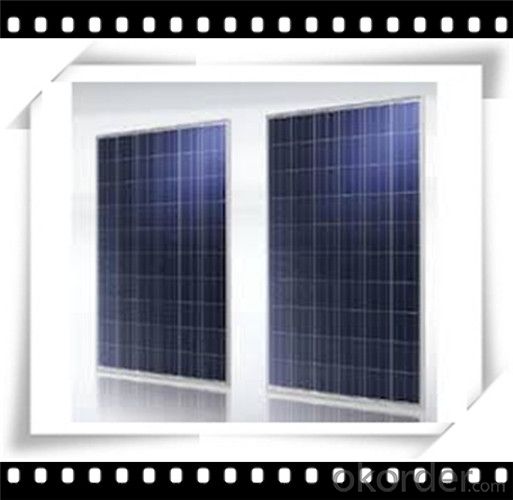
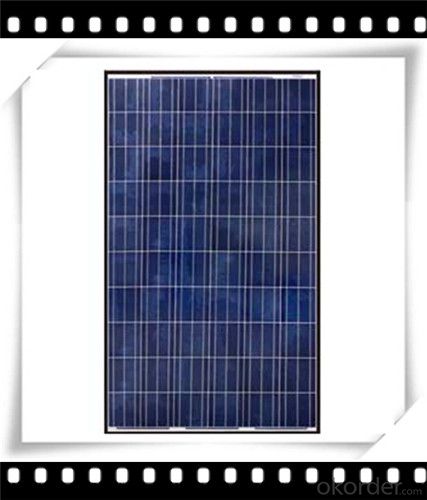
Specifications:
+/-3% |
Polycrystalline silicon solar cells (156 x 156mm) |
60 (10 x 6) |
1650 x 990 x 40 |
25.5 |
Limits:
Operating Temperature | -40~+85? |
Storage Temperature | -40~+85? |
Maximum System Voltage | 1000 VDC max. |
Hail Impact | Diameter of 28mm with impact speed |
Temperature and Coefficients:
NOCT | 48C+/-2? |
Voltage temperature coefficient (%/K) | -0.35 |
Current temperature coefficient (%/K) | 0.05 |
Power temperature coefficient (%/K) | -0.45 |
Characteristics:
Model: | SGM-200P | SGM-210P | SGM-220P |
Max-power voltage Vmp (V) | 29.2 | 29.4 | 29.41 |
Max-power current Imp (A) | 6.85 | 7.14 | 7.48 |
Open-circuit voltage Voc (V) | 36.5 | 36.69 | 36.9 |
Short-Circuit Current Isc (A) | 7.28 | 7.6 | 7.93 |
Max-power Pm(W) | 200 | 210 | 220 |
Model: | SGM-230P |
Max-power voltage Vmp (V) | 29.8 |
Max-power current Imp (A) | 7.72 |
Open-circuit voltage Voc (V) | 37.31 |
Short-Circuit Current Isc (A) | 8.19 |
Max-power Pm(W) | 230 |
STC: Irradiance 1000W/m2, module temperature 25?, AM-=1.5
Poly Crystalline Solar Panels Specifications Range
Maximum Power (Pm) | Dimension | Weight | Operating Voltage (Vmp) | Operating Current (Imp) | Open Circuit Voltage (Voc) | Short Circuit Current (Isc) |
0.45W | 140x80x10mm | 0.08kg | 3.3V | 150mA | 4.6V | 160mA |
1.0W | 162x140x10mm | 0.16kg | 7.5V | 150mA | 10.3V | 160mA |
4.5W | 269x251x23mm | 0.8kg | 16.5V | 0.27A | 20.5V | 0.3A |
10W | 420.1×268.9×22.6mm | 1.92kg | 17.5V | 0.58A | 20.5V | 0.6A |
20W | 425x502x50mm | 3.0kg | 16.8V | 1.19A | 21.0V | 1.29A |
30W | 593x502x22.6mm | 3.9kg | 16.8V | 1.78A | 21.0V | 1.94A |
40W | 655x537x50mm | 5.75kg | 17.3V | 2.31A | 22.1V | 2.54A |
50W | 839x537x50mm | 6.0kg | 17.5V | 2.9A | 21.8V | 3.17A |
65W | 1111x502x50mm | 7.2kg | 17.6V | 3.69A | 22.1V | 3.99A |
80W | 1204x537x50mm | 7.7kg | 17.6V | 4.55A | 22.1V | 4.8A |
- Q: I have two solar panels that were going to be trashed at work. I want to use them to charge batteries on my RV but i noticed they put out around 20 volts in direct sunlight. So i am wondering: -isn't this way too much voltage for a 2 volt system? -do a need some sort of a regulator connected to keep them from overcharging?
- 20 volts is a common open-circuit voltage for nominal 2v panels. The panels put out about 5v at full load. If the panel puts out little enough that it takes 20 hours or more to put a full charge in the battery you can get by without a charge controller - just keep the cells topped up with distilled water. A charge controller will do a more efficient job, though. The most efficient charge controllers use what's called Maximum Power Point Technology (MPPT) which lets the panels operate at their most efficient point throughout the battery's charging cycle. Available on OKorder. The charge controller should have the same or higher wattage as the panels it controls - if you're not sure of wattage, assume that they are the same as similar area panels you find for sale. Before buying a charge controller, connect the panels through an ammeter to a discharged battery. They may have been trashed because of damage and low output. You need at least an amp for trickle charge, 5 amps for reasonable recharge times.
- Q: they are pretty expensive. So does it save you money on electricity in the long run? How easy is it to connect solar panels to your house?
- yes. Its pretty simple connection. It does save money on electricity.
- Q: Can solar panels be used in areas with high humidity?
- Yes, solar panels can be used in areas with high humidity. However, high humidity levels can affect the overall efficiency of solar panels due to a decrease in their performance. The moisture in the air can cause a film of dirt or dust to accumulate on the panels, reducing their ability to absorb sunlight effectively. Regular cleaning and maintenance can help mitigate these effects and ensure optimal performance.
- Q: Can solar panels be used to power an entire home?
- Yes, solar panels can be used to power an entire home. With the right number of solar panels and a proper energy storage system, it is possible to generate enough electricity to meet the energy needs of a household. However, it is important to consider factors such as energy consumption, geographical location, and system size to determine if solar panels alone can entirely power a home.
- Q: I had an idea for new parabolic solar panels shaped like horseshoes. They can install them outside buildings facing the equator. They could angle them from the ground based on how many degrees latitude the location and rotate them according to seasonal changes. The disadvantage of photovoltaic panels is that they are not all capable of receiving direct sunlight. That is the quintessential reason I believe horseshoe solar panels are more effective than flat rectangular ones. One side could function in the morning; the middle could perform at midday; and the other could operate during the evening. That method seems more sensible than hourly positioning. I'm certain horseshoe panels could save and produce more electricity. A football stadium, shopping mall, or outlet center would be a fantastic place. What do you think?
- Sounds like you are thinking which is excellent. Now do a controlled experiment. Using a prototype of your receiver and measure it against existing technology. You could do a computerized mock up.
- Q: how efficient are flexible solar panels?
- One I got about 3 years ago is about 50% as efficient as a glass panel I got about 0 years ago. Not exactly a scientific study, I know.
- Q: I found portable solar panels used for boats etc. and was wondering how I could effectly use them for my home instead. If you have used them in the past, please tell how they worked (good or bad).
- portable panels are too small to be much use for a modern household. A panel appx 20 inches square might supply a laptop computer... but it won't keep your refrigerator running.
- Q: Got a small project here in a remote location. There is to be a 2 volt deep cycle battery, the equipment to be powered from battery and solar panel to charge battery. The 2 volt battery puts out 55 AH. the max constant power draw from the equipment to be powered is 7.9 watts. Will a 30 watt panel at 2 volts be enough to run this system during sunlight and charge the battery for the equipment to run overnight?And, at 55 AH, how long can I keep a constant draw of 7.9 watts without a recharge?Thanks to all the input!
- Will a 30 watt panel at 2 volts be enough to run this system during sunlight and charge the battery for the equipment to run overnight? Maybe theoretically, but you're going to have very little margin for losses and clouds. I'll bet it has very little power when cloudy. 7.9/30 = 0.26. So at 00% efficiency, you'd need it to be charging more than 25% of each 24 hour period. In a summer with long days and a climate with few clouds, you might make it. But I think you're very close to the edge. And, at 55 AH, how long can I keep a constant draw of 7.9 watts without a recharge? For an ideal battery: time = Q V / P time = 55 A h * 2V / 7.9W time = 83 hours So you've got pretty good margin on your battery.
- Q: How can I calculate the amount of watts needed for a solar panel to power a water and air pump in gal/hr and a 600 watt LED light?
- Mimi: Solar Power is not really that economical, and has many other disadvantages as well. You did not specify much info in your question as to the size of the water or air pump. So let's make some assumptions to get you some numbers. ) Let's say the water and air pump are about HorsePower (HP). The HP pump , considering efficiency losses, will draw around ,000 Watts , or kW. 2) The 600 Watt LED Light is quite high --- they are usually much smaller lights 40 Watts or less. BTW --- these LED lights are very expensive light as well. Just so you are aware. Between the pump(s) ( maybe 000 to 400 Watts) and the 600 Watt light ----- and without knowing the specifics --- you are probably looking at around 2,000 Watts or 2 kW. A 2 kW Solar PV unit will run around $20,000. The PV unit will only run at full capacity during daylight hours. They usually average about 5 hours per day. So you will only be able to run your pump and LED Lights during the middle of the day --- maybe 0:00 AM to 5:00 PM. If you want to run the pump and lights after sundown, you will need battery back-up. The electric storage batteries will likely run about an extra $5,000. They will last about 5 years. If you decide this doesn't work out well --- you can stay with the local utility --- at $0.0 per kWh. It will cost you about $0.0 per hour to run the pump --- maybe 30 to 50 cents per day. It would cost you about 6 cents per hour to run your light. Maybe 30 or 40 cents per day. You could essentially run your pumps and light several hours each day --- all for about $ per day, or $365 per year. This sounds like a less costly alternative.
- Q: I have this question for extracredit and I dont get it?How many 2V,2W PV panels would be required to supply a load that requires a 48-volt supply that can push at least 2.8 amps of current, if you assume each panel puts out A at 2 V? And how are the panels configured to supply the power requirements of the load?
- i agree with Liz but have a diffrent point i think u have not calculated for the roof mounted solar panels i am giving youy a bsic understanding hope that will help you Roof Mounted solar power systems consist of solar panels held in place by racks or frames which are attached to roof based mounting supports. Roof based mounting supports include: Pole mounts which are attached directly to the roof structure and may use additional rails for attaching the panel racking or frames. Ballasted footing mounts such as concrete or steel bases that use weight to secure the panel system in position and do not require through penetration. This mounting method allows for decommisison or relocation of solar panel systems with no impact on the roof structure.
Send your message to us
Aaa Solar Panels 250w Poly Medium Newest CNBM Solar Panel
- Loading Port:
- Qingdao
- Payment Terms:
- TT OR LC
- Min Order Qty:
- 10 set
- Supply Capability:
- 300000 set/month
OKorder Service Pledge
OKorder Financial Service
Similar products
Hot products
Hot Searches
Related keywords
